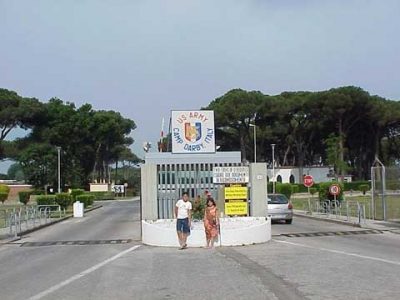Under the Tricolor Flag Flying at Camp Darby. US Military Hegemony in Italy Prevails
The US Army granted the Italian Ministry of Defense a portion of the base (34 hectares, about 3% of the entire area of 1,000 ha.)

While many activities blocked by the lockdown are struggling to restart after the restriction’s relaxation, there is something that never stopped, and is now accelerating: Camp Darby, the largest US arsenal in the world outside the motherland, which is located between Pisa and Livorno.
After cutting about 1,000 trees in the “protected” natural area of San Rossore Regional Park, the construction of a railway section connecting the Pisa-Livorno line to a new loading and unloading terminal across the Canale dei Navicelli on a new revolving metal bridge, began.
The almost twenty meters high terminal will include four tracks capable of accommodating nine wagons each. By means of container-handling trolleys, incoming weapons will be transferred from railway wagons to large trucks and weapons leaving will be transferred from trucks to railway wagons. The terminal will allow the transit of two trains per day, which will connect the base to the port of Livorno through densely populated areas, carrying explosive loads.
Following the increased movement of weapons, the connection through the canal and the Camp Darby road to the port of Livorno and Pisa airport is no longer sufficient. In the base’s 125 bunkers, continuously supplied by the United States, more than one million artillery shells, aircraft bombs and missiles are stored (according to rough estimates), to which thousands of tanks, vehicles and other military materials are added.
Since 2017, new large ships, capable of carrying over 6,000 vehicles and loads on wheels each, make monthly calls to Livorno, loading and unloading weapons that are transported to the ports of Aqaba in Jordan, Jeddah in Saudi Arabia and other Middle Eastern airports to be used by U.S. and Saudi and other forces in the wars in Syria, Iraq and Yemen.
Just as the expansion of Camp Darby, the largest US arsenal abroad, is underway, an online Tuscan newspaper headlines “Once upon a time Camp Darby”, and explained that “the base has been scaled down for defense cuts decided by US governments. ” and the newspaper Il Tirreno announced “At Camp Darby only the Italian flag flies: the USA flag has been lowered after almost 70 years”. Is the Pentagon closing the base, returning the territory on which it was created to Italy? It is quite the contrary.
The US Army granted the Italian Ministry of Defense a portion of the base (34 hectares, about 3% of the entire area of 1,000 ha.) previously used as a recreation area, for the Italian Special Forces Command transfer ( Comfose), initially housed in the Gamerra barracks in Pisa, the parachuting training center seat (the manifesto, 5 March 2019).
The transfer took silently place during the lockdown and now Comfose announced that its headquarters are located in the “new military area”, in fact annexed to Camp Darby, a base where US and Italian soldiers’ joint training has been taking place for some time. The Comfose transfer to an area annexed to Camp Darby, formally under the Italian flag, allows the full integration of the Italian special forces with the US forces, using them in covered operations under US command. They are all under the hood of military secret.
Visiting the new Comfose headquarters, Defense Minister Lorenzo Guerini called it not only the Special Forces ” nerve center” but also of the “Army Psyops Units”. The task of these units is “to create the consensus of the local population towards the military contingents employed in peacekeeping missions abroad”, or to convince them that invaders are peacekeepers.
Finally, Minister Guerini indicated the new headquarters as a model for a “Green Barracks” project. A model of “well-being and eco-sustainability”, which lays on a million explosive warheads.
*
Note to readers: please click the share buttons above or below. Forward this article to your email lists. Crosspost on your blog site, internet forums. etc.
This article was originally published in Italian on Il Manifesto.
Manlio Dinucci is a Research Associate of the Centre for Research on Globalization.

